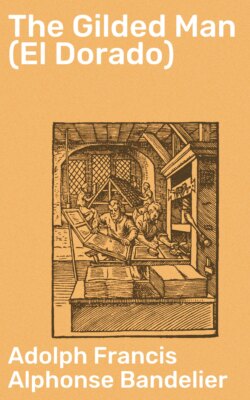The Gilded Man (El Dorado)

Реклама. ООО «ЛитРес», ИНН: 7719571260.
Оглавление
Adolph Francis Alphonse Bandelier. The Gilded Man (El Dorado)
The Gilded Man (El Dorado)
Table of Contents
Cundinamarca. CHAPTER I
Meta
CHAPTER II
Omagua
CHAPTER III
CHAPTER IV. THE EXPEDITION OF URSUA AND AGUIRRE
CIBOLA
INTRODUCTION
CHAPTER I. THE AMAZONS
CHAPTER II. THE SEVEN CITIES
CHAPTER III. FRANCISCO VASQUEZ CORONADO
CHAPTER IV. THE NEW MEXICAN PUEBLOS
Quivira
CHAPTER V
THE MASSACRE OF CHOLULA (1519)
THE AGE OF THE CITY OF SANTA FE
JEAN L'ARCHEVEQUE
Отрывок из книги
Adolph Francis Alphonse Bandelier
Published by Good Press, 2020
.....
Among the many lakes of the table-land of Bogotá known as such places of offering, the lake of Guatavitá became eminently famous as the spot where the myth of el dorado, or the gilded man, originated. This water lies north of Santa Fé, on the páramo of the same name, picturesquely situated at a height of 3199 metres above the sea. A symmetrical cone, the base of which is about two hours in circumference, bears on its apex the lake, which has a circuit of five kilometres and a depth of sixteen fathoms. The bottom of the lake is of fine sand. Near this water, at the foot of the páramo, lies the village of Guatavitá. The inhabitants of this place about the year 1490 constituted an independent tribe. A legend was current among them that the wife of one of their earlier chiefs had thrown herself into the water in order to avoid a punishment, and that she survived there as the goddess of the lake. Besides the Indians of the tribe of Guatavitá, pilgrims came from the communes around to cast their offerings of gold and emeralds into the water. At every new choice of a uzaque of Guatavitá, an imposing ceremonial was observed. The male population marched out in a long procession to the páramo. In front walked wailing men, nude, their bodies painted with red ochre, the sign of deep mourning among the Muysca. Groups followed, of men richly decorated with gold and emeralds, their heads adorned with feathers, and braves clothed in jaguars' skins. The greater number of them went uttering joyful shouts, others blew on horns, pipes, and conchs. Xeques, or priests, were in the company, too, in long black robes adorned with white crosses, and tall black caps. The rear of the procession was composed of the nobles of the tribe and the chief priests, bearing the newly elected chieftain, or uzaque, upon a barrow hung with discs of gold. His naked body was anointed with resinous gums, and covered all over with gold-dust. This was the gilded man, el hombre dorado, whose fame had reached to the seacoast.[12] Arrived at the shore, the gilded chief and his companions stepped upon a balsa and proceeded upon it to the middle of the lake. There the chief plunged into the water and washed off his metallic covering, while the assembled company, with shouts and the sound of instruments, threw in the gold and the jewels they had brought with them. The offerings completed, the chief returned to the shore and to the village of Guatavitá. The festival closed with dancing and feasting.[13]
Till about the year 1470 the tribe of the Tunja was the most powerful clan on the highland; at that time the Muysca of Bogotá[14] began to extend their dominion. Their chief, or zippa, Nemequene, overcame the Guatavitá Indians in the last decade of the fifteenth century, and made them tributary. With that he put an end to the ceremony of the dorado. The gilded chief had ceased to wash off his glittering coat in the waters of Guatavitá thirty years before Juan de Ampues founded the colony of Coro, but news of this change on the highlands of Cundinamarca had not yet reached the coast, and the dorado still continued to live in the mouths of the natives there.
.....